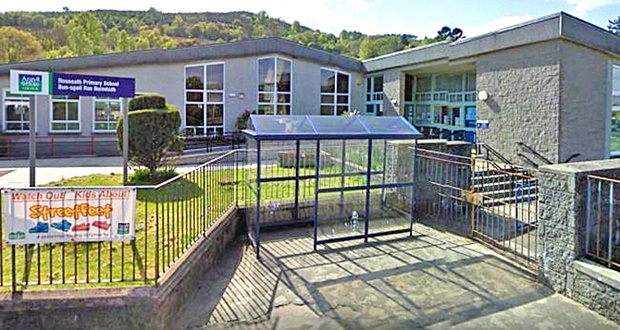
Thanks to Alistair McIntyre for his article of January 2019
Rosneath has been favoured by the presence of a school for a very long time indeed. That is mainly due to the fact that it has existed as a parish from as far back as mediaeval times, with Rosneath Village (Clachan) at its centre. At the heart of the mediaeval parish was the church, and one had been in existence at Rosneath from possibly as far back as the so-called “Dark Ages”, now known as the Early Mediaeval period. An evangelist known as Modan (which may well be derived from two words: “Mo Aiden”, i.e. “My Aiden”) is traditionally understood to have settled there and established a religious centre in the remote past. In possible support of such a claim, it is worth mentioning that in 1880, when work was being carried out in the grounds of the present St Modan’s Church, a carved stone was found buried about five feet underground. Now kept inside the Church, it has been dated stylistically experts to around 800 AD, and is thought by many to commemorate Modan himself. Some people think that the site chosen by Modan might even have been considered sacred in pre-Christian times.
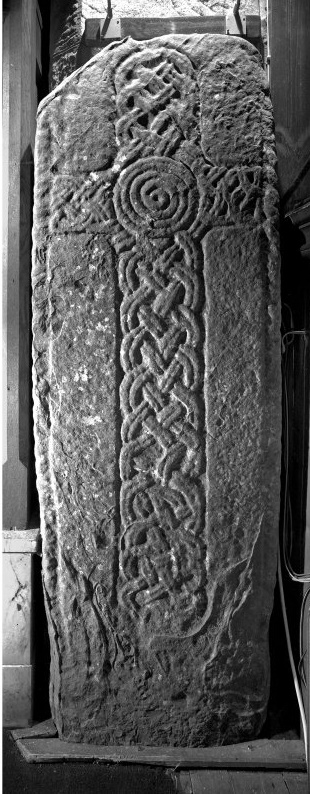
It is not known exactly when the first school at Rosneath was founded. In the mid-16th century, the religious reformer, John Knox, put forward a plan for a school in every parish, but this was not realised until many years after his death. However, Acts of the Scottish Parliament were passed in 1646 and 1696, making it a legal requirement for each parish to establish a school. This was to be paid for by the heritors local landowners). Here, it should be noted that much of the parish was then owned by the Earls and later, the Dukes of Argyll.
Although there may have been earlier teachers, the first definite name to emerge from the mists of time is that of Robert Monro, who was parish schoolmaster at Rosneath, probably in the early 18th century, and certainly before 1717. The first teacher for whom an exact date can be given is a John McNaughton, who became parochial schoolmaster on, or shortly before, 1800.
It is vital to bear in mind that although the Acts of the Scottish Parliament made a school in every parish a legal necessity, attendance at school was not compulsory. Some parents may well have wished basic reading and writing skills to be imparted in their children, but for most families, the priority was to have children contributing to family income as soon as possible. The majority of those children who did attend school probably would have done so only for a limited period.
The parish schools, although financed by the landowners, were actually under the control of the church, and schoolmasters – no lady teachers, had they existed- would have been put in charge of parish schools, and at that time were required to sign a document called the Confession of Faith. This procedure was carried out in a bid to ensure that teachers did not carry any views that were considered to be different from those of the Established Church.
The link between church and school was further underlined by some additional roles that were expected of the schoolmaster, over and above his teaching duties. He would be expected to serve as clerk to the Kirk session, and to act as precentor (the person who led the singing) at church services. He might well have additional duties, such as recording marriages and births, and was usually in charge of Sunday School. As recompense for all these duties, the master received payment, though the amounts were very small.
The parish schoolmaster was expected to put religious teaching at the heart of the curriculum. The pupils would all be taught to read and write, with the Bible and the Shorter Catechism (a set of questions and answers) as the main texts. Discipline was strict, with the cane and the tawse (leather strap) ready to hand. Hours were long, with lessons in some places starting as early as 6 am.
The master was obviously a key figure in the community, but this was not reflected in his income, which was very meagre, considering all his responsibilities. The salary had been set by the Acts of 1646 and 1696 at a minimum of 100 merks, and a maximum of 200 merks per annum. (200 merks was a little over £11 sterling). These salary levels were still in place more than a century later. The Old Statistical Account of Scotland, drawn up in the 1790’s, and made up of reports submitted by every parish minister, repeatedly refers to the inadequate salaries of teachers. Here, it is worth pointing out that in many cases, schoolmasters had originally been educated with a career in the ministry in mind, but had subsequently been unable to obtain a living in that capacity. The parish minister might thus have felt some special sympathy for his poorly-paid compatriot.
According to the Old Statistical Account, the schoolmaster’s total income at Rosneath, from all sources, was stated to be a little under £17 per annum in 1790. Fees were at that time payable for instruction: at Rosneath, quarter fees for reading were one shilling (five pence in today’s money); for reading and writing, one shilling and sixpence; for reading, writing and arithmetic, two shillings. Latin incurred a higher fee, but this had not been taught at Rosneath for several years. The cost of living was of course very much lower at that time. Fees were payable by parents, but for those in very poor circumstances, parish funds were usually available to help out.
There was one other totally unexpected and shocking source of income for schoolmasters in some places. A widespread custom seems to have developed up and down the country whereby the master undertook to organise cockfights to take place at his school. Defeated birds and “refuseniks” became the property of the master, destined for his cooking-pot. This unseemly and barbaric practice lingered on in some districts until the early 19th century. No evidence has come to light to suggest that Rosneath School staged such events.
After 1803, there were modest increases in salary. A house was now also provided for the master and his family, but this could vary in suitability. In this respect, the master at Rosneath was probably better placed than many: his schoolhouse at the end of the Clachan comprised the upper floor of a substantial building with gable end to the then church, the school itself being conducted from the ground floor.
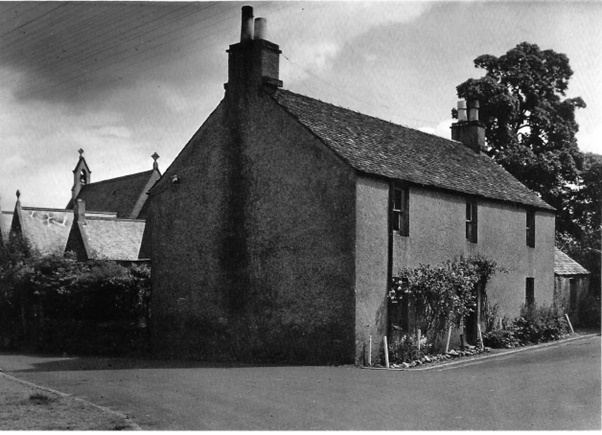
While the existence of a parish school at Rosneath was infinitely better than none at all, it has to be realised that travelling there on a daily basis from the more distant parts of the parish was simply not practicable, particularly for younger children, and especially in the winter. Whilst education was not compulsory, there was undoubtedly a desire on the part of many parents for their children to receive at least some education. This is hinted at by the coming into existence of schools over and above the parish school, especially from about 1700 onwards. There had in fact been schools other than parish schools long before that date – for example, Dumbarton Grammar School was in existence in 1514, and quite possibly long before – but relatively few children could ever hope to attend such an institution.
One example of a school other than the parish one was that conducted at Letter, near Coulport. Recorded as being there in 1800, it was being taught by a John McFarlan. Even though it was not the parish school, it would appear to have been established with the approval of the church. That is implied by the presence of McFarlan’s signature in the Confession of Faith document. At one stage there was also a school at Rahane. Bodies like the Society for the Propagation of Christian Knowledge also helped sponsor schools around this time, although there is no evidence of one on the Peninsula.
In 1808, John Graham became parish schoolmaster at Rosneath, and probably remained there until about 1820. In 1810, there were some 40 pupils attending, and the total income of the schoolmaster was £40. In 1820, John Dodds was appointed schoolmaster at Rosneath, where he was to remain in post for a remarkable fifty years. He was still master at Rosneath at the time of his death in 1870.
John Dodds is the first schoolmaster at Rosneath about whom there is much information. It is of interest that there exists an account of Dodds and his school written by a former pupil called John McEachern. Born on the island of Mull in 1809, McEachern and his family moved shortly after his birth to Glen Fruin, his father being in search of work. In 1821, they moved to Hill of Camsail, Rosneath. So it was that John and other young family members came to attend Rosneath School. This is his story, written much later in life: –
“Mr Dodds was then in his first or second year of teaching at Rosneath. He was an excellent teacher of Greek, Latin, French, German, mathematics, navigation, geometry, algebra, bookkeeping, drawing, and indeed all the qualifications necessary for a schoolmaster in any country parish in Scotland. Being a young man from the Borders, and taught in the best colleges in Scotland, with the most approved modes of pronunciation, and so on, the parish reaped much improvement by his school.
“He was a man of very civil, attractive manners, who took much pleasure in the improvement of his pupils, and in conjunction with the Rev. Robert Story, the Parish minister, whose Manse was in sight of the schoolhouse, every kind endeavour was used for the moral and spiritual training of the children”.
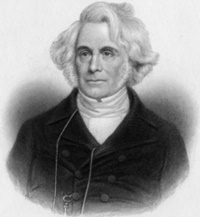
In 1830, the McEachern family emigrated to Prince Edward Island, Canada, but John evidently retained very favourable memories of his youthful years at Rosneath. His descendants still live on Prince Edward Island.
A different, but equally favourable assessment of John Dodds comes from the writings of local historian W. C. Maughan. Here is what Maughan has to say in “Rosneath Past and Present” (1893):-
“The late respected Mr John Dodds….for fifty years taught the youth of the parish… Here assembled not only the sturdy, chubby-faced young children of the farmers and their labourers, but the families of the resident gentry were also glad to enjoy the privilege of the admirable tuition dispensed by Mr Dodds.
“In addition to the ordinary branches of knowledge imparted in the parish schools of Scotland, Mr Dodds taught the higher departments of mathematics, land-surveying and navigation, and gave competent instruction in French. Many of his pupils gained distinction in various walks of life, and remembered long, with kindly affection, the thorough grounding in education acquired at the Rosneath School.
“Mr Dodds filled other posts in connection with the Parish and Church, and for twenty years was kind enough to act as Postmaster, upon most inadequate remuneration…..Dr James Dodds, the esteemed parish minister at Corstorphine, is a son of the worthy old schoolmaster of Rosneath”.
It should be borne in mind that few, if any, of the pupils would have received instruction in all the subjects offered by John Dodds. Relatively few parents would have been able to afford to keep their children at school for more than several years, though for those of special ability, financial support might have come from other quarters – the Scots have traditionally prided themselves in their view that, while educational opportunity in the old days might have been far from perfect, there was at least a fighting chance that a really able boy (never a girl) of humble birth, would be able to proceed to higher education.
It seems too, that adults were enabled to attend Rosneath School – John McEachern himself records that he returned to spend a winter at Dodds’s school after 1827, when he would have been aged 18 or over. Indeed, when John lived in Glen Fruin, he mentions that when he first attended Abercrombie’s school there, it was in the company of his uncle, Neil Fletcher, who wished to better his education in arithmetic and book-keeping, Fletcher subsequently moved to Hill of Camsail, where he himself ran a school for a short time prior to the arrival of John Dodds. Small “ad hoc” schools like this were not uncommon.
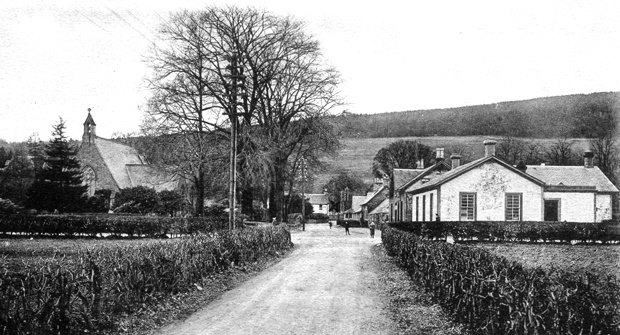
It was during the time of John Dodds’s tenure at Rosneath that a new school was built. In 1835, a fine new building was erected at the foot of the Clachan. This served as school right until the opening of the present school building in 1967. The school of 1835 thereafter served for some years as a community centre, but was then closed, becoming steadily more and more derelict in appearance. Latterly owned by the Co-op, it was the subject of a great deal of criticism as an eyesore until its demolition in the last couple of years. In a way, it is a pity that a building, so long associated with the education of local youth, should at the end be regarded as nothing more than a nuisance.
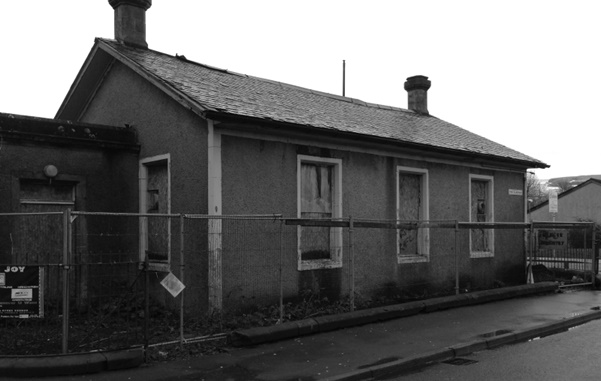
Another key source of information on the life and times of Rosneath Parish School is the New Statistical Account of Scotland. As with the Old Statistical Account, this was a parish-by parish account of the whole country, and again the parish minister was the author of each entry. The section dealing with Rosneath Parish was written by the Rev. Robert Story, and his most helpful report, drawn up in 1839, has this to say about the school: –
“The different branches of a commercial and classical education are very efficiently taught by the parochial schoolmaster, and every day, the children under his care are instructed in the principles of religion. The average attendance may be rated at 70, although in the winter season, upwards of 100 are sometimes at school.
“The schoolhouse (i.e. the school itself) was built a few years ago, a very handsome and commodious structure, superior to any in the county, and reflecting great credit at once upon the liberality and taste of the Heritors. The schoolmaster’s house is at a little distance from it, immediately contiguous to the Church, with accommodation much superior to what the statute provides for that class of most deserving men. The garden is much less than the legal dimensions, but he enjoys an allowance in lieu of that deficiency.
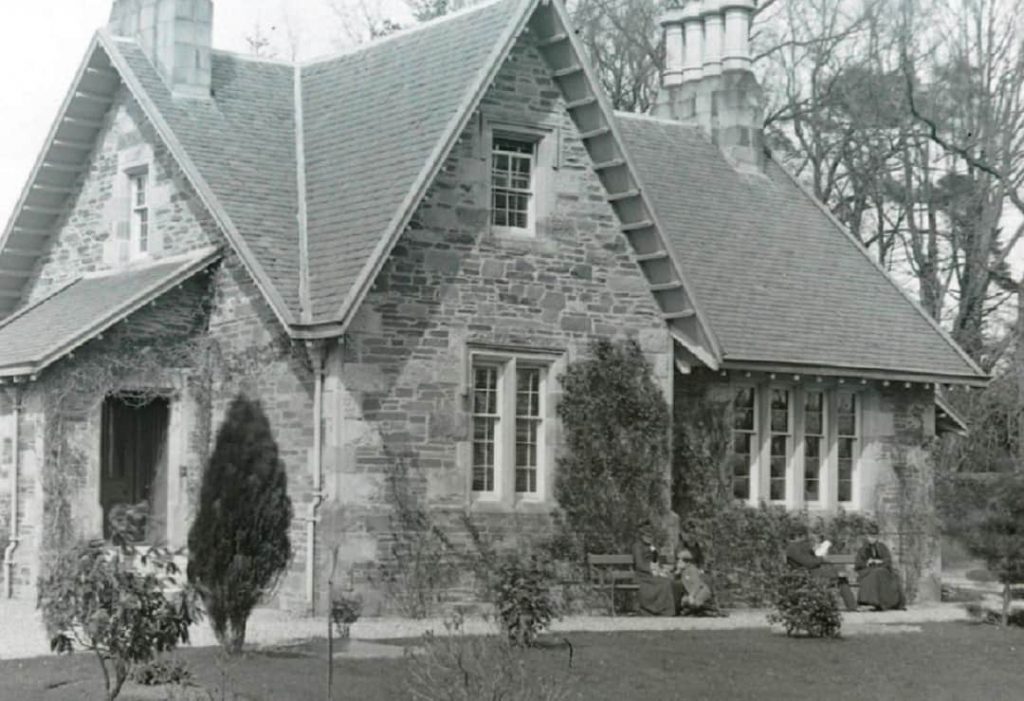
The salary is the maximum, with the fees 2/6d for reading, 3/- for writing, and 3/6d for arithmetic, and this may constitute an income of between £70 and £80 per annum.
“The only other school in the parish is at Knockderry. The teacher there has a salary of £35 a year, guaranteed to him by Mr Lorne Campbell, factor to His Grace, and although the parents pay at the rate of 5/- per quarter for each child, the fees fall greatly short of the sum guaranteed, from the circumstance of the school commanding pupils from a very limited population, but whose distance from the parish school rendered its erection necessary, the expense of which was solely met by the Duke of Argyle. Although less, it is built upon the same principle as the parochial school-house. Both houses are much more commodious than that at present is needful, and it may be considered as anticipating any increase in population for a century to come.
“It may be stated that the people are universally anxious to have their children educated. All the natives of the parish, male and female, are taught at least to read and write, and although individuals from time to time are found that can do neither, they are generally natives of Argyleshire, servants to the different farmers”.
Note that in the above passage, numbers attending school were higher in winter than in summer. This was the normal state of affairs – in the summer, children were expected to assist with labour-intensive work on the farm like hay-making, lifting of potatoes, and so on
It is interesting that after the very long tenure of John Dodds at Rosneath, his successor also spent a long time in post. In 1870, William Stewart was appointed as master, a position he held until his retirement in 1905. By that time, monumental changes in education were taking place. Indeed, just two years after Stewart took up his duties, the landmark Education (Scotland) Act of 1872 was passed. Also known as Young’s Act, this remains the single most important date in the history of Scottish education, because, for the first time, education became compulsory for those aged between 5 and 13 years. There were, however, numerous exceptions and provisions for “half-time” attendance. While education for all now had the force of law behind it, school fees were still chargeable to parents, albeit at a very moderate level. These were finally abolished in state schools in 1889. The new legislation brought most schools, including the parish ones, under the state, thus replacing church control.
The name of Rosneath Parish School now changed to that of Rosneath Public School. Each school under the new system was now administered by a school board, in this case the School Board of the Parish of Rosneath. In practice, school administration was perhaps not so radically different from previous arrangements, at least initially. True, members of school boards had to stand for election, but Heritors (landowners) and ministers, the people most closely involved with school management in the past, often put themselves forward as candidates. The continuity between old and new was further reinforced by William Stewart undertaking the role of clerk to Rosneath Kirk Session, in time-honoured fashion.
Under the system of parish schools, there may have been an element of external supervision, but with the school boards, there were established formal periodical inspections, a feature of school life that has of course continued to this day!
Social changes were also afoot in the wake of the new regime. In due course, female teachers began to be employed, though normally only as assistant teachers. The only schools where a woman would be in charge at this time would have been either very small, female only, or private. Female teachers had to be unmarried or perhaps widowed: any move towards a marital state meant instant dismissal. In this context, it should be noted that Peaton Public School, which came into being in the wake of the 1872 Act, and lasted until the early 1920’s, was mostly conducted by a lady teacher.
Comment might also be in order about other changes that had been sweeping across the Peninsula and beyond. The coming of the steamboat to the Clyde in 1812, and the later arrival of the railway, had made it much easier than before for people to move around. At the same time, the rapid urbanisation of the Central Belt, and the emergence of a new class of well-off business and professional people, led to a growing demand around the Clyde Coast for plots of land on which to build villas. Another potent factor in the mix was the realisation by landowners that here was an opportunity to raise much-needed revenue to support their own plans and ambitions.
Feuing of land for house-building at prime coastal locations thus became the outcome. Although Helensburgh had set the feuing ball rolling as early as 1776, the intention here was probably somewhat different, with initial focus on providing opportunities for cottage industries like bonnet-making and weaving, a possible motivating factor being concern for those displaced from the land in the wake of the agricultural improvements then in vogue.
Feuing at Barremman began in 1825, at Rhu in 1831, at Garelochhead in 1832, and at Shandon in 1834. It was probably inevitable that feuing should also begin on the Duke of Argyll’s Rosneath Estate, which occupied the whole Peninsula, apart from the smaller estates of Peaton and Barremman, and extending almost as far north as the recently-renovated Oakfield Cottages, nestling at the foot of Whistlefield Hill.
It could be convincingly argued there was a more pressing need to start feuing land for house-building on Argyll’s estate than on those close by, thanks to the legacy of the profligate lifestyle of George Campbell, Marquis of Lorne, later the 6th Duke of Argyll. He died in 1839, but his extravagance meant that Rosneath and other family estates remained in a perilous position for many years afterwards. Indeed, Rosneath Estate was even put on the market in 1870 and 1873, but no sale was concluded.
Be it as it may, feuing at Cove and Kilcreggan began in the 1840’s, and before long, a line of fine villas and even mansion – houses stretched for miles along the shores of Loch Long. The momentum gained enabled Cove and Kilcreggan to become a police burgh in 1865, and boast its own school within the next two years.
The extensive practice of feuing plots for house-building round the Peninsula and Gareloch led to a swelling of the population, and here it should be realised that this applied not only to householders themselves: many also employed domestic servants, some with their own families. The majority of house-owners and servants were incomers, people who might well have been expected to feel less affiliation to the existing social order and practices than long standing natives. Even so, nothing has come to light to suggest that integration of locals and incomers at school and elsewhere was in any way fractious. This was still a society where most people knew and accepted their place in it.
It should also be emphasised that a high proportion of feuers were people of some. means, and the houses they built could often be looked upon as holiday homes. Cove and Kilcreggan in particular saw a number of very wealthy businessmen build grand residences there. For the most part, well-off incomers would have had their children educated elsewhere, but of course the children of their servants would have attended schools such as that at Rosneath.
William Stewart remained as headmaster at Rosneath for a noteworthy 35 years, not so much has come to light about him as his predecessor. Nonetheless, there is short but fascinating description contained in the autobiography of a son of the manse at Rosneath, Charles Warr. The second son of the Rev. Alfred Warr, minister at Rosneath from 1887 until his death in 1916, Charles, who was born in 1892, brings us into the world of Stewart as superintendent of the Sunday School. This is how Charles remembered him: –
“The schoolmaster was one of the last of the old Scottish dominies. A scholarly, solemn, bearded man, impeccably dressed and of great dignity, his patriarchal appearance gained for him throughout the parish the irreverent sobriquet of “The Man o’ God”. The “Man o’ God” had a dismal outlook on human affairs. One of the great truths he was wont to impress upon the urchins of the Sunday School was that they began to die the moment they were born. His choice of hymns reflected his attitude to life. A great favourite was sung to the melancholy tune “Moravia” (it focussed on the dead in churchyards). But the children, being children, bawled these hymns with great enjoyment at the top of their voices. During prayers, the boys caused excessive hurt to the girls with their savage pinches.
“The Sunday School had its value, if only in the insistence on memorisation, then in vogue. Every week, the children had to learn by heart some verses from the greater passages of the Bible, a portion of the Shorter Catechism, and also a number of verses from a metrical psalm or paraphrase. They had to learn the Commandments, the Beatitudes, the Creed, and the Lord’s Prayer…. A generation was thus reared which carried out into life a certain cultural and religious endowment which never left them. There was not a child in the parish who did not attend Sunday School, and every lad and lass went to the Bible Class”
Charles has not very much to say about Rosneath School itself, for the simple reason that he did not attend it for very long. When he came of school age, his father arranged for him to attend a private school at Hillside, Clynder. Run by a Miss Campbell, Hillside was primarily a boarding school for girls, but boys were also taken on a day basis up to twelve years of age. Miss Campbell evidently wore dentures, because at the initial pep talk, Charles distinguished himself by asking her, in all innocence: “How is it that you can move your teeth when I can’t?”.
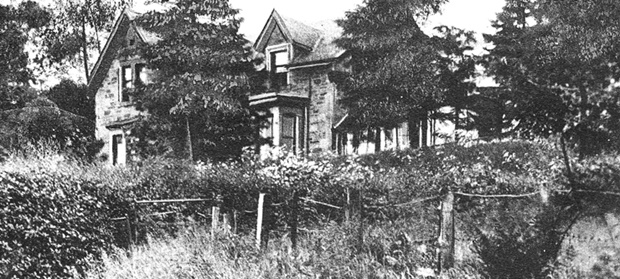
There came a time when Miss Campbell had to close her school for a year, for personal reasons, so there was a problem for Rev. Warr about what to do about his son’s schooling. As it so happened, there happened to meet together at the manse at this time, both the Duke and Lorne Campbell of Peaton. The subject of Hillside cropped up, and the Duke and Lorne Campbell agreed that for young Charles, the closure was no bad thing, and that he would greatly benefit from spending at least a year at Rosneath School.
However, an incident happened next which was to change all that. One day, there was a visit to the manse by Princess Louise, who was of course married to the Duke. She embraced Charles, but as she did so, he inadvertently came in contact with a boiling kettle. As he mentions in his memoirs, he had managed to pick up some fairly earthy terminology in the school playground, and now made good use of several choice phrases in consequence of the scalding. Once the Princess had made sure that Charles was none the worse, she laughed off the episode, but the Rev. Warr was livid with fury. Taking his son from the room, he demanded to know where he had learned “those dreadful words”. So ended Charles’ time at the village school. Badly wounded in the First World War, he went on to have a distinguished career as a churchman himself.
“So, I found myself at the village school. I enjoyed it hugely….I stayed there for the best part of a year.”. This was probably around 1902.
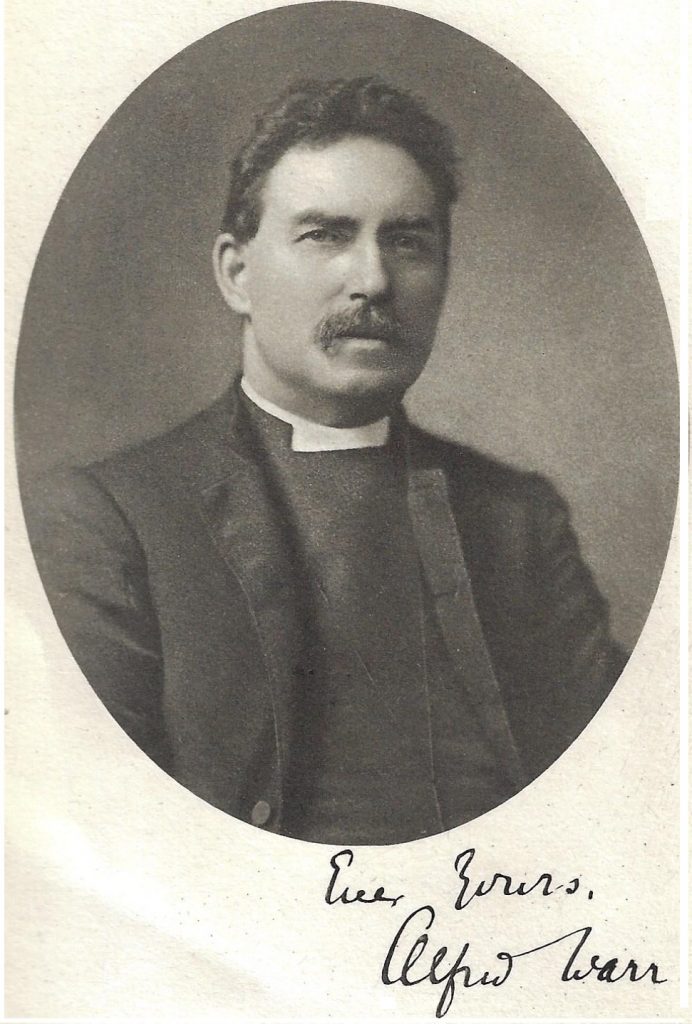
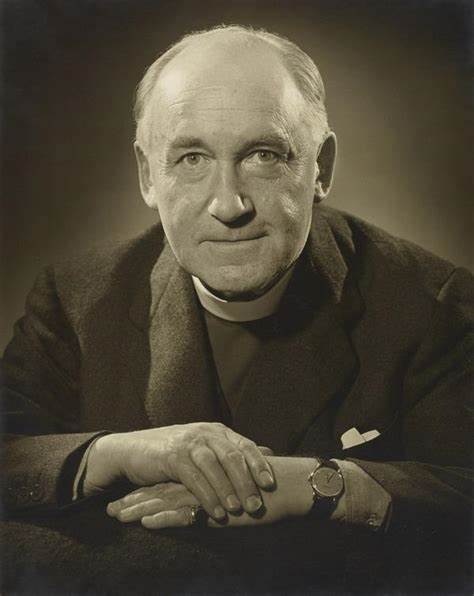
In view of this incident, it is interesting to note that the Rev. Warr was a member of Rosneath School Board around this time, and indeed served as chairman for a number of years. For interest, voting in the 1906 elections to Rosneath School Board produced the following outcome. There were 5 places available: –
D.B. Anderson, Brookvale, Cove…………………. 458 votes
Rev. A. Warr, the Manse, Rosneath……………….. 344 votes
John Currie, Woodbine Cottage, Kilcreggan….. .246 votes
Thomas McGregor, Clynder View, Clynder……..211 votes
Robert C. Keir, Cona Cottage, Clynder……………196 votes
Matthew Howie, Home Farm, Rosneath………….163 votes
William McCracken, Ellerslie, Cove………………..54 votes
Miss Jessie Bain, Craigowlet, Cove………………….46 votes
If this result from Rosneath is typical of the period, it suggests that by the turn of the century, while church influence was still to the fore, landowner representation had tailed off.
With the retirement of William Stewart in 1905, the new head teacher appointed in his place was George Young. In his new colleague, Miss B. Stewart, he would have found helpful continuity in that she had also served for some years under William Stewart. Indeed, given the surname common to both, one might well wonder if they were related. Miss Stewart went under the title of “Headmistress”, presumably because she taught the girls.
Another Education Act in 1908 gave further powers to school boards. As far as the children themselves were concerned, there was now provision, through school attendance, for medical and dental care, while food and clothing were to be available for the very needy. These features were symptomatic of the more caring society that was emerging, but it also coincided with a time of increasing international tension – children on the Peninsula would have seen clear evidence of this through signs such as Portkil Fort and its mighty guns, dating from the early years of the new century, a statement of intent should any hostile warships enter the River Clyde.
The First World War, when it did come, wrought terrible death and injury among combatants, with communities up and down the country suffering accordingly. Rosneath was no exception, and a number of former pupils, serving with the armed forces, were killed or injured. Charles Warr is but one example – he was very fortunate to survive, having suffered severe injury at the bloody and prolonged Battle of Ypres. Yet, in spite of all, the Second World War was to have significantly greater overall impact locally than this earlier conflict.
As the First World War drew to a close, further educational change was afoot, with the passage of the Education (Scotland) Act, 1918. The 538 School Boards were abolished and replaced by 38 Education Authorities, one of which was Dunbartonshire Education Authority. Many people had sought to have education brought under the control of the county councils, but political pressure meant this did not happen until there was fresh legislation in 1928. In other words, the Education Authorities were free-standing bodies, albeit under state control.
There was also a second tier of administration, with schools like Rosneath coming under the influence of Helensburgh District School Management Committee, on which Rosneath Parish had two representatives. This Committee reported to the Education Authority. Roman Catholic and Episcopalian schools, hitherto under separate control, now came into the state system. Here, it is worth mentioning that country schools like Rosneath have always been non-sectarian, and this arrangement has served the community well across the years. The 1918 Act also brought teachers’ salaries up to a more reasonable level.
The new legislation had a clause for raising the school leaving age to 15 years- it had already been raised from 13 to 14 in 1901 – but in fact this aim was not enacted until there was fresh legislation in 1945. It should be emphasised that for those of sufficient ability and the necessary parental support, the possibility of progress to higher education had long been available. This was helped by the existence of grants and endowments. Any such ambition had been enhanced in 1888, with the introduction of the Scottish Leaving Certificate. This provided a tangible target and stepping stone for those aspiring to proceed along the academic road. The Certificate normally entailed studying at certain schools which offered more advanced courses. For many children, however, their formal education would have begun and ended at Rosneath School.
In actual fact, Dunbartonshire Education Authority had proposed in 1921 the transfer of pupils from schools like Rosneath to one in Helensburgh after reaching the age of 12 years. Such an outcome might certainly have provided a stimulus for those considering a move to more advanced study, but the idea met with opposition. There may have been further turns and twists on that front, but nationally at least, it was not until 1945 that a system of primary and secondary schools, with automatic transfer from one to the other, was realised
The switch of education from Education Authority to County Council control, brought about in 1928, carried with it a second tier of administration, not much different from that previously in existence. Helensburgh District School Management Committee had some 13 schools under its control. Perhaps unexpectedly, these did not include Luss and Muirlands, several miles south of Luss.
The early 1920’s saw the appointment of a new headmaster at Rosneath, Matthew Cross. As well as his role as a teacher, it was not long before he too, was also serving as clerk to Rosneath Kirk Session. Interestingly, his assistant was still Miss B. Stewart, who in consequence had now served under three different head teachers. By this time, some very well qualified women indeed were coming through the educational system, although they were still finding it virtually impossible to obtain senior teaching posts.
In the mid 1920’s, Matthew Cross was replaced as head teacher by George Glennie, who was still in post at the onset of the Second World War. This conflict had an enormous impact in the area, not so much from direct death and destruction, but rather through the setting up of a vast military infrastructure. With the return of peace, a good deal of this was retained, and in several cases greatly expanded, with Coulport and Faslane serving as two prime examples. During the War itself, life of course had to go on, with the usual routines of school, albeit along with black-out and gas- mask training, coupled with the presence of child evacuees from the big towns and cities.
Just months before the outbreak of war, an historic link with the past had been broken, with the death of Princess Louise in 1939. Her consort, the 9th Duke of Argyll, had predeceased her in 1914, and since then, Rosneath Estate had been in the hands of trustees. The death of the Princess effectively heralded the sale of the Estate, which had been in the hands of the Argyll family since the 15th century. By 1943, the Estate had been sold off: it was symbolic of the end of one era and the dawn of another.
As if in keeping with the changed circumstances, the conclusion of wartime coincided with the passage of another monumental piece of legislation, the Education (Scotland) Act, 1945. Pupils as well as staff would witness big changes as a result. Among other things, the school leaving age was finally raised to 15, this being coupled with an 11+ streaming exam, and the creation of separate schools for nursery, primary and secondary education.
In consequence of the changes, Rosneath Public School now became Rosneath Primary School, and after 7 years of primary education, it became necessary for pupils to proceed to secondary education in Helensburgh or Dumbarton.
With the nearest state secondary school being the Hermitage in Helensburgh, the strain on the infrastructure there must have been considerable, with the school having to cope not only with the new older pupils in the town itself, but also those flooding in from all the villages in the catchment area. It is interesting that the school at Kilcreggan, roughly similar in size to Rosneath, seems to have operated for a few years as a junior secondary school. Whether or not this stemmed from the burgh status of Cove and Kilcreggan is unclear, but whatever the case, it must certainly have helped provide a breathing space for the beleaguered Hermitage, until it had sorted out the business of extra accommodation and staffing. The 11+ exam was abolished in 1965, but the system of primary and secondary schools has of course continued.
As far as the social landscape is concerned, one big post-war change was a climate in which female teachers could now realise their true potential. So it was that by the 1950’s, Rosneath had its first female head teacher in the shape of Mrs Elizabeth McLachlan. Other schools in the district were also making similar breakthroughs, with Luss and Garelochhead being but two further examples.
A useful snapshot of the school in the mid 1950’s can be gained from the Rosneath entry in the Third Statistical Account of Scotland. This is what the Rev. Dr. Cameron Dinwoodie had to say about the school:-
“Rosneath is a three-teacher school with a roll just under 80. All secondary pupils from the two schools at Rosneath and Kilcreggan are taken by bus to Hermitage Secondary School in Helensburgh”.
Mrs McLachlan proved to be not only a dedicated teacher, but also a very community-minded person as well. For example, in 1960, she, in association with five other like-minded people, was the driving force behind the formation of a charitable body called the Roseneath Anvil Trust. The inspiration for so doing seems to have come from the earlier example set by some local people, headed by the Rev. Dinwoodie, who, in the wake of the break-up of Rosneath Estate in the 1940’s, set up ” Rosneath Clachan Trust”, the aim of which was to purchase and preserve the old cottages making up the Clachan of Rosneath. Once the houses were purchased, they were then made over to the tenants. The oldest building in the Clachan was thought to be the smiddy – hence the name of the new trust set up by Mrs McLachlan and others.
A considerable capital sum of money was put together, then invested. The interest from the investments has allowed donations to local good causes to be made ever since. For example, the last two years has seen sizeable donations made to causes such as the purchase of a defibrillator, the Peninsula Churches Together Holiday Club, and Rosneath Highland Games.
By the 1960’s, the population of Rosneath was greatly expanding, mainly due to the coming of the Polaris submarine-based defence system. This resulted in a large expansion of the civilian work-force at Coulport and Faslane, and a consequent need for extra housing. Helensburgh was to provide the biggest quota, with 740 new houses, but the Lochside villages also took their share, with 60 houses planned for Rosneath. The population had already been growing, but with the projected massive influx, the need for a new school became paramount. It was decided that the ideal location was the site of the former mansion known as Clachan House.
Clachan House had an interesting history. Thought to date from the 18th century, it was said to have been built on the site of a monastery. One possible echo of a spiritual connection came in the form of a trackway running from the house direct to Rosneath Church. This was lined on either side by trees, famous as the Yew Tree Avenue. The house was once home to the Campbells of Mamore, the most prominent member among whom was General John Campbell of Mamore, later the 4th Duke of Argyll. It was later occupied successively by Robert Campbell, the Duke’s factor; John Douglas Campbell of Peaton, and Robert Howie of Clachan Farm. By the late 19th century, though, it had fallen into poor condition and was tenanted by several families.
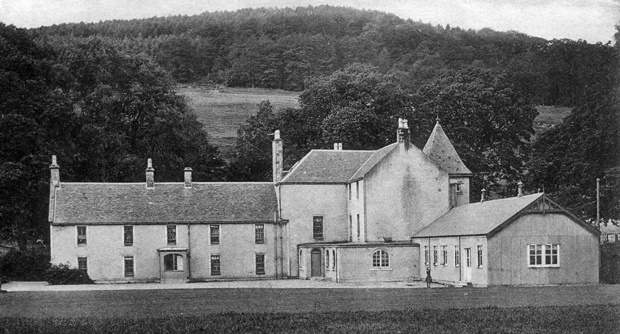
The house had a change of fortune around the turn of the 20th century, when it was renovated as an abode for Princess Louise. During the Second World War, it formed the base for a team of Royal Engineers. They were cautioned about the ghost that frequented it, known as “The Grey Lady of Clachan House”, and were consequently terrified by some strange noises one evening- it turned out to be the house cat playing with a marble! By the end of the war, the house had again fallen into poor condition, and was gutted by fire in 1962.
The new School was designed by the Glasgow-based firm of Ross and Lindsay. The whole construction was an imaginative and multi-purpose one, incorporating as it did not only a spacious and airy building with six classrooms, but in addition a linking general-purpose room, which could be used by the school. However, it could also serve, when necessary, as a stage for the Village Hall. Likewise, linked to the general-purpose room, was a Library, this to be staffed by the County Library Service. The School had originally been planned to have four classrooms, but with the recent big increase in population, this had been allowed for with two extra rooms. Fine new playing fields had also been provided.
The splendid new facility was officially opened on the ceremony being performed by James Roy, Provost of the Burgh of Cove and Kilcreggan. In his speech, he referred to the new facility as “one to be proud of”. The Head Teacher, Miss Elizabeth McKay, a native of Rosneath, expressed her joy at the new School, and said she had admired it from Clachan Hill, and from the Gareloch. At that time, she was supported by seven colleagues, along with two visiting teachers. There were 106 pupils on the roll.
This was an era of further change: the 11+ exam had been abolished shortly before, and around this time, many primary schools were dispensing with the annual prize-giving ceremony- months before the opening of the new Rosneath School, Hermitage Primary had announced the cessation of the practice. New ideas and teaching methods were also being brought in. The succeeding decades witnessed many more changes.
The year 1975 saw yet another change in the administration of education, namely the abolition of county councils, and their replacement by a new 2-tier system, comprised of regional councils and district councils. Education was a function of the regional councils, and in consequence, Rosneath, as with other state schools in the area, came under the massive Strathclyde Regional Council. The district council for the area, Dumbarton District Council, did not have education as a core function.
By this time, influences that had already been in existence for quite some time, were assuming ever greater importance. The ever-increasing complexity of educational planning and delivery was placing more and more responsibility on teaching staff, with the consequent need for administrative support. The use of technology in schools for use in teaching and administration was also on the increase, including the use of radio programmes, a practice dating from the 1940’s and 1950’s, followed by beamed TV programmes. By the early 1980’s, schools were also becoming involved with the use of computers.
A ground-breaking application of the new technology came about in 1986, with the BBC Domesday Project. Schools from all over the country were encouraged to submit information, and the result has provided an invaluable historical record., with Rosneath School being among those participating. We thus learn that Miss McKay was still the Head Teacher at Rosneath, and that following the opening of the new School in 1967, the roll had risen at one stage to a peak of 259. There were currently some 191 children on the roll. The Head Teacher was supported by seven classroom colleagues, four of whom commuted from Helensburgh, along with one part-time remedial teacher. The former school was being used as a community centre.
The 1990’s witnessed the demise of the regional and district councils, and their replacement by single-tier local authorities, this being affected in 1996. Another major change at this time was the transfer of part of the former Dumbarton district, namely Helensburgh and District, to the newly-formed Argyll and Bute Council. Education was, and remains, a key function of this unitary body.
The school roll at Rosneath in the 1990’s was somewhat lower than had been the case in the 1970’s and 1980’s. Thus: 1992-170; 1993-148; 1994-152. This reduction can also be seen in other schools in the area, and probably reflected a national trend of smaller families.
By the dawn of the new Millennium, it was becoming clear that changes in information technology and communications were affecting not only education, but society generally, especially through developments such as personal computers, the World Wide Web, and the Internet. More recently, we have seen the emergence of the “smart phone”, the power of which is truly breath-taking. Information of all kinds can now be had readily at the mere press of a button. In consequence, a good deal of information about Rosneath School can readily accessed today by almost anyone.
Even so, the need for a dedicated and proficient staff in taking the school forward remains paramount. This is borne out by the report of an HMI inspection, carried out in 2003, thus: –
“With the effective leadership of the head teacher, and the strong commitment and teamwork of all staff….the school had improved in key areas of its work….there continues to be a very positive ethos within the school…the head teacher and the staff had worked hard to establish good relationships with pupils….the school placed strong emphasis on partnership with parents…classroom assistants, administrative, janitorial and catering staff are actively involved with the life of the school, and contribute effectively to the school’s positive behaviour policy….”.
The above example is very useful in demonstrating both the complex demands of modern educational provision and the key part played by those other than teaching staff in the life of the modern school. Even more recently, a report from 2017 notes: –
“ROSNEATH PRIMARY GOES FROM STRENGTH TO STRENGTH”, and goes on to describe how the School had benefited from the Government’s Attainment Scotland Fund launched 18 months before. One of 57 schools across the country taking part, the scheme had led to significant improvements in the learning process, including reading and literacy.
There can be no doubt that Rosneath School, an institution with a very long and distinguished pedigree, can take great comfort from the fact that this tradition of excellence is being maintained. Present Head Teacher, Mrs Emma McDermid, and all her staff, have a great deal of which to be proud.
We request your help – Do you have pictures of Miss McKay and the opening of the new School in 1967, or can you provide an update for Rosneath Primary since 2019?
Please can you send any pictures or articles you may have. All will be returned once scanned into the History Image library.
